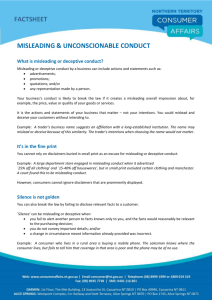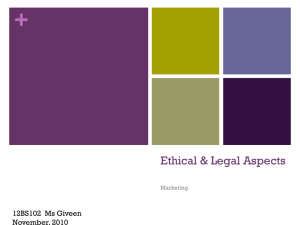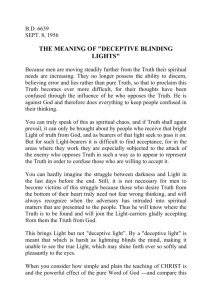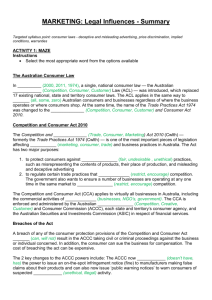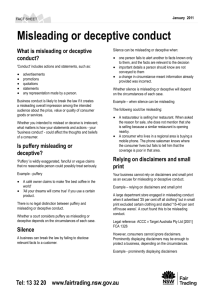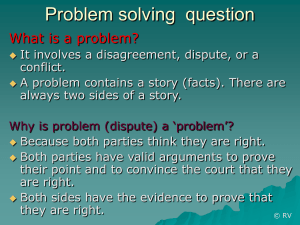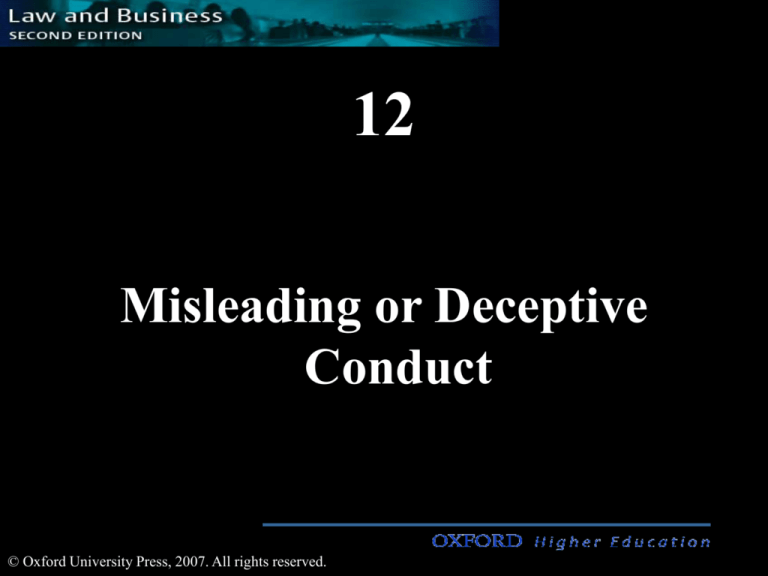
12
Misleading or Deceptive
Conduct
© Oxford University Press, 2007. All rights reserved.
Misleading or deceptive
conduct: section 52 TPA
Main objectives:
• understand parameters of the provision
• understand the relationship between the statutory
provision and the common law of misrepresentation.
Misleading or deceptive
conduct cont ...
Section 52 provides that “a corporation shall not,
in trade or commerce, engage in conduct that is
misleading or deceptive or is likely to mislead
or deceive.”
Misleading or deceptive
conduct cont…
Therefore threshold requirements of s 52 are:
• corporation (or people who fall within extended reach
provisions, in particular s 6)
• in trade or commerce
• must not engage in conduct
• that is misleading or deceptive.
Misleading or deceptive
conduct cont…
Scope of s 52:
• wide scope given to notion of engaging in conduct
– much broader than concept of representation at
common law
• ‘mislead’ and ‘deceive’ also interpreted broadly
• objective test whether or not particular conduct
actually misleads or deceives or is likely to
mislead or deceive somebody else.
Misleading or deceptive
conduct cont…
• not fault related: no intent required
• “likely to mislead or deceive”: added in 1977
• “likely to” refers to situations where conduct has
potential to mislead or deceive, eg. important in
context of false and misleading advertising.
Unnecessary to prove that the conduct in question
actually mislead or deceived anyone.
Misleading or deceptive
conduct cont…
• however, in context of pre-contractual negotiations, to
obtain damages under s 82 (which requires causal
connection between deceptive conduct and any loss
suffered), you have to show that the conduct actually
did mislead you.
• see generally Brown v Jam Factory.
Misleading or deceptive
conduct cont…
Circumstances where there may be a s 52 remedy even
though there may not be an action at common law:
•
•
•
•
cases of puffing or exaggerated sales talk
silence in certain circumstances
opinions
statements as to the future: statements of intention
and false predictions or forecasts.
Misleading or deceptive
conduct cont…
Note effect of s 51A:
• s 51A provides that where a corporation makes a
representation as to any future matter without a
reasonable basis or without reasonable
grounds, the representation shall be deemed to be
misleading or deceptive for the purposes of s 52.
Misleading or deceptive
conduct cont…
• s 51A reverses the onus of proof: the corporation has
to prove that, at time of statement, they had a
reasonable basis for it (rather than the plaintiff having
to prove that the corporation had no basis for it)
• impact: s 52 covers statements or predictions as to the
future which are made honestly but carelessly.
Misleading or deceptive
conduct cont…
Remedies:
s 80 (injunctions)
s 80A (corrective advertising)
s 82 (damages)
s 87 (orders)
• note that damages are available under s 82 for innocent
misrepresentation which falls within scope of s 52 (compare
common law position)
• s 82 requires ‘a person to have suffered loss or damage by
conduct of another person’ - causal connection required.
Misleading or deceptive
conduct cont ...
Reform to remedies:
Note introduction of proportionate liability • where loss is caused by more than one defendant,
or the plaintiff contributes to their own loss, court
must apportion liability to reflect each party’s
contribution to the loss.
Misleading or deceptive
conduct cont…
To summarise: implications of s 52• broad scope and flexibility - thus s 52 often
provides a better remedy to a buyer than an action
for breach of contract
• fewer pre-conditions
• not limited to consumer transactions
• not fault related
• superior range of remedies
Misleading or deceptive
conduct cont…
• re remedies: in particular damages available for
innocent misrepresentation falling within scope of
s 52
• bars to rescission do not automatically apply
• post contractual conduct
• courts will not generally enforce exclusion clauses
in context of s 52 claims.


